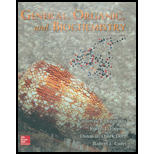
(a)
Interpretation:
The boiling point of solution that contains
Elevation in boiling point:
Boiling point is the temperature at which vapor pressure becomes equal to atmospheric pressure. If a non volatile solute is added then the vapor pressure get lowered. So, more temperature has to be provided for vaporizing. Hence the boiling point increases.
Where,
(a)
Answer to Problem 3MCP
That is boiling point of magnesium chloride solution is
Explanation of Solution
Molar mass of
Number of moles of
Molality of the solution can be calculated as follows,
Magnesium chloride dissolves in water and produces three ions in solution. So total concentration of ions in solution will be
Therefore elevation in boiling point can be calculated as follows,
So the boiling point of the solution will be
That is, melting point of solution is
(b)
Interpretation:
The melting point of solution that contains
Depression in freezing point:
At freezing point solid phase of the solvent will be in equilibrium with liquid phase. When solute molecule is added, it will interfere with the rate at which the liquid molecules associate to form solid state, hence lower the freezing point of the solution.
Where,
(b)
Answer to Problem 3MCP
That is melting point of magnesium chloride solution is
Explanation of Solution
Molar mass of
Number of moles of
Molality of the solution can be calculated as follows,
Magnesium chloride dissolves in water and produces three ions in solution. So total concentration of ions in solution will be
Therefore elevation in boiling point can be calculated as follows,
So the melting point of the solution will be
That is, melting point of solution is
(c)
Interpretation:
One practical application where a solute is used to alter the boiling point of a liquid has to be provided.
(c)
Explanation of Solution
During cooking salt is added before or while heating, in order to increase the boiling point so as to get higher temperature for food items.
(d)
Interpretation:
One practical application where a solute is used to alter the melting point of a liquid has to be provided.
(d)
Explanation of Solution
During winter season, salt is put on ices on road so that that it melts and easy passage for vehicles.
(e)
Interpretation:
Among the same concentrated solution of magnesium chloride and acetone, the one with higher melting point has to be determined.
(e)
Explanation of Solution
Magnesium chloride is an ionic compound, so it dissociate in solution and give three ions per mole but acetone is a covalent compound and will not dissociates. Therefore total ion concentration for magnesium will be more. Colligative properties depend on particle concentration. Hence depression in freezing point will be more for magnesium chloride solution. So, the melting point is more for acetone solution.
(f)
Interpretation:
Among the same concentrated solution of magnesium chloride and acetone, the one with higher boiling point has to be determined.
(f)
Explanation of Solution
Magnesium chloride is an ionic compound, so it dissociate in solution and give three ions per mole but acetone is a covalent compound and will not dissociates. Therefore total ion concentration for magnesium will be more. Colligative properties depend on particle concentration. Hence elevation in boiling point will be more for magnesium chloride solution. So, boiling point is more for magnesium chloride solution.
(g)
Interpretation:
Osmotic pressure of
Concept introduction:
Osmotic pressure (
Where,
(g)
Answer to Problem 3MCP
Osmotic pressure of
Explanation of Solution
Number of moles of magnesium chloride can be calculated as follows,
Therefore molarity of magnesium chloride solution is given below.
Molarity of magnesium chloride solution is
Given temperature is
The value of universal gas constant is
There will be three ions per mole of the solution, because magnesium chloride dissociates to give one magnesium ion and two chloride ions.
Therefore osmotic pressure can be calculated as follows,
Osmotic pressure is
Want to see more full solutions like this?
Chapter 6 Solutions
GENERAL,ORGANIC,+BIOCHEM.(LL) >CUSTOM<
 ChemistryChemistryISBN:9781305957404Author:Steven S. Zumdahl, Susan A. Zumdahl, Donald J. DeCostePublisher:Cengage Learning
ChemistryChemistryISBN:9781305957404Author:Steven S. Zumdahl, Susan A. Zumdahl, Donald J. DeCostePublisher:Cengage Learning ChemistryChemistryISBN:9781259911156Author:Raymond Chang Dr., Jason Overby ProfessorPublisher:McGraw-Hill Education
ChemistryChemistryISBN:9781259911156Author:Raymond Chang Dr., Jason Overby ProfessorPublisher:McGraw-Hill Education Principles of Instrumental AnalysisChemistryISBN:9781305577213Author:Douglas A. Skoog, F. James Holler, Stanley R. CrouchPublisher:Cengage Learning
Principles of Instrumental AnalysisChemistryISBN:9781305577213Author:Douglas A. Skoog, F. James Holler, Stanley R. CrouchPublisher:Cengage Learning Organic ChemistryChemistryISBN:9780078021558Author:Janice Gorzynski Smith Dr.Publisher:McGraw-Hill Education
Organic ChemistryChemistryISBN:9780078021558Author:Janice Gorzynski Smith Dr.Publisher:McGraw-Hill Education Chemistry: Principles and ReactionsChemistryISBN:9781305079373Author:William L. Masterton, Cecile N. HurleyPublisher:Cengage Learning
Chemistry: Principles and ReactionsChemistryISBN:9781305079373Author:William L. Masterton, Cecile N. HurleyPublisher:Cengage Learning Elementary Principles of Chemical Processes, Bind...ChemistryISBN:9781118431221Author:Richard M. Felder, Ronald W. Rousseau, Lisa G. BullardPublisher:WILEY
Elementary Principles of Chemical Processes, Bind...ChemistryISBN:9781118431221Author:Richard M. Felder, Ronald W. Rousseau, Lisa G. BullardPublisher:WILEY





